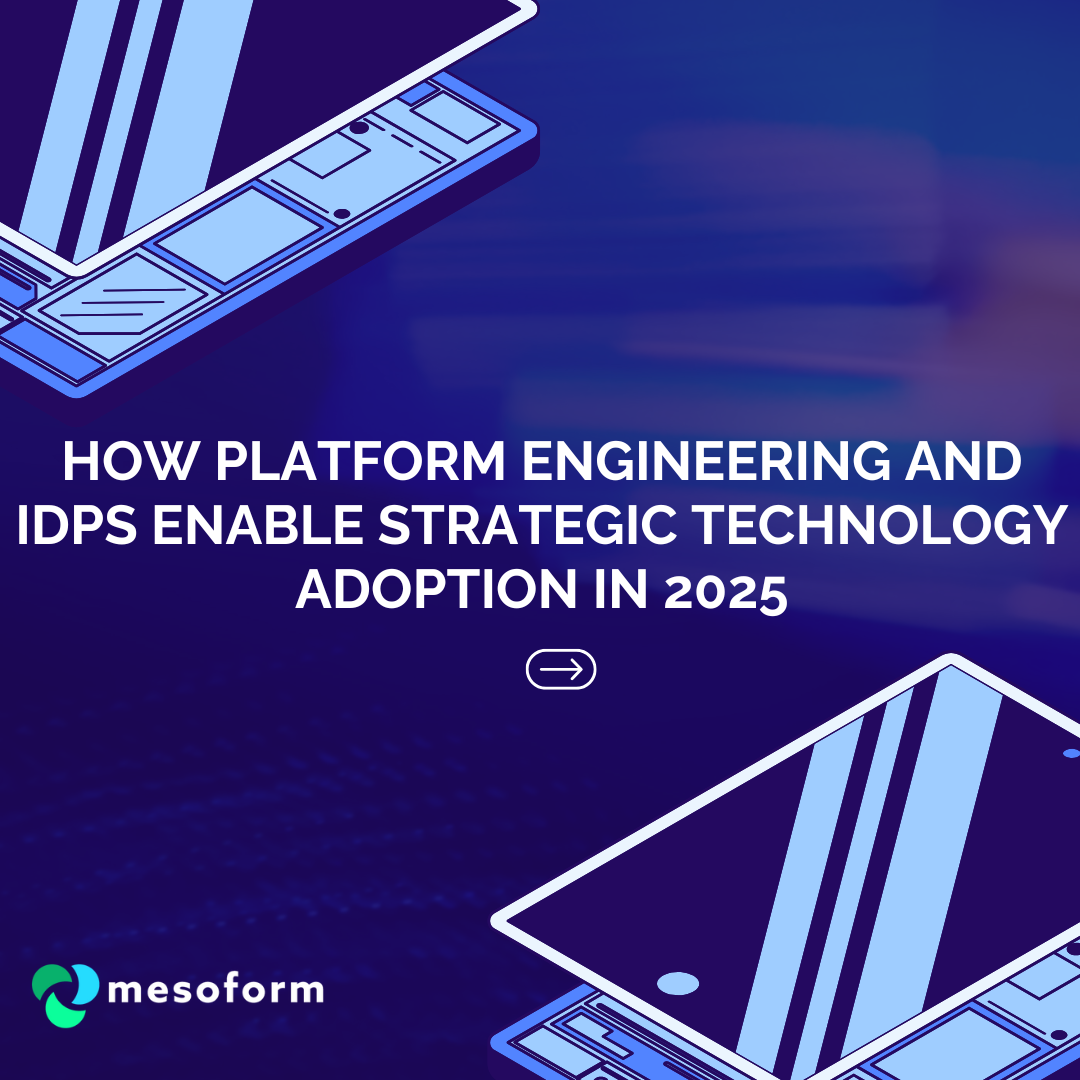Platform Engineering: The Strategic Layer Between Vision and Execution
Platform engineering is not new, but just like how some engineering teams had been doing DevOps before it was labelled and became this massive industry changing movement, the same is true for platform engineering. We know because we have been one of those early teams. However, for most, that is not the case, and now that it has been productised and popularised it is fast becoming the strategic enabler of enterprise-grade technology management.
At its core, platform engineering involves building internal platforms that abstract infrastructure, security and compliance complexities and provides developers with self-service capabilities, best practice deployment pattens (“golden paths”), and standardised workflows. These platforms act as a bridge between technical operations and application teams, balancing autonomy with governance, speed with safety.
While trends like Agentic AI, post-quantum cryptography, and spatial computing grab headlines, none of them can be successfully deployed without solid engineering foundations, built on repeatable processes, secure environments, and frictionless tooling.
That’s exactly what platform engineering delivers.
Internal Developer Platforms: Enabling Outcomes Through Engineering
An Internal Developer Platform (IDP) is the practical implementation of platform engineering principles. It provides development teams with the tools and environments they need to build, test, deploy, and monitor applications — without waiting on ops or security teams to manually provision resources.
The goal? To enable faster delivery with built-in reliability, security, and scalability.
Let’s explore how IDPs support organisations in aligning with 2025’s top strategic technology trends:
1. Operationalising Responsible AI Development
As AI evolves from experimentation to operational necessity, organisations must balance innovation with control. Trends such as Agentic AI and AI governance platforms highlight the dual priorities of speed and ethical oversight.
How Platform Engineering Helps:
Developers can spin up pre-configured environments with dedicated GPU access, data sandboxes, and AI model registries.
IDPs enforce AI-specific policies such as version control for models, audit trails for datasets, and pre-deployment testing against bias or explainability metrics.
Standardised pipelines integrate with MLOps tools, enabling safe experimentation within approved boundaries.
Outcome: Empowered data science teams who can innovate without bypassing governance processes.
Our platform has already supported several clients in deploying AI workloads safely and at scale, including enforcing policy-driven controls for LLM training and automated explainability.
2. Accelerating Multi-Environment Deployments Across Hybrid and Edge Architectures
With trends like hybrid computing, ambient intelligence, and energy-efficient computing, organisations are increasingly deploying across multiple environments—cloud, on-premise, and edge. These setups offer flexibility but add complexity.
How IDPs Bridge the Gap:
Provide consistent, reusable templates for deployment—whether to AWS, Azure, on-prem Kubernetes, or embedded edge devices.
Automate environment configuration using infrastructure-as-code and GitOps principles.
Offer observability tooling and performance benchmarking across diverse footprints.
Outcome: Seamless deployment to hybrid environments with reduced cognitive load for developers.
3. Enhancing Security in a Post-Quantum and Disinformation-Driven World

Security trends such as post-quantum cryptography (PQC) and disinformation security demand a proactive approach to cryptography, identity verification, and runtime protection.
What Platform Engineering Enables:
Create test environments to evaluate PQC algorithms without risking production integrity.
Automate certificate rotation, secrets management, and cryptographic library updates.
Integrate identity-aware proxies and runtime monitoring into every service by default.
Outcome: A proactive security posture, with less risk and fewer bottlenecks in rollout cycles.
4. Supporting Immersive and Human-Centric Technologies
Trends like spatial computing, neurological enhancement, and polyfunctional robots require rapid feedback loops between users, devices, and backend systems. This introduces new demands around latency, simulation environments, and sensor data ingestion.
How Platform Engineering Responds:
Offers local development environments that mirror production settings for AR/VR, robotics, or IoT use cases.
Provides telemetry ingestion pipelines and real-time dashboards out of the box.
Enables testing of human-machine interfaces in safe, sandboxed scenarios.
Outcome: Confidence in deploying immersive or mission-critical systems without infrastructure delays.
5. Sustainability and Cost Control by Design
Sustainability is not just a board-level priority—it’s a technical challenge. With energy costs rising and legislation tightening, energy-efficient computing isn’t optional.
What IDPs Do:
Monitor energy and resource usage per service, per environment, per team.
Help route workloads to energy-efficient regions or low-carbon data centres.
Provide visibility into unused or inefficient resources to drive cost optimisation.
Outcome: Sustainability becomes measurable, not just aspirational
Strategic Benefits of Platform Engineering
Beyond enabling specific trends, platform engineering delivers broad, organisation-wide benefits:
| Benefit | Impact |
|---|---|
| Developer Experience | Reduces friction, increases productivity and satisfaction. |
| Operational Consistency | Lowers risk by enforcing best practices and reducing environment drift. |
| Faster Time-to-Value | Shrinks cycle times from idea to deployment. |
| Security by Design | Embeds guardrails into every stage of the development lifecycle. |
| Organisational Agility | Supports rapid experimentation with controlled rollout. |
At Mesoform, we design IDPs that are tailored to your teams, your stack, and your goals. Whether you’re modernising legacy applications or exploring next-gen AI agents, your platform is the engine behind it all.
Building for 2025 and Beyond
The technology landscape of 2025 is marked by promise—but also by complexity. Platform engineering provides a structured way to de-risk innovation, scale new capabilities, and align your developers with your strategic objectives.
The question is no longer if you need a platform strategy—but how quickly you can operationalise one.
Mesoform’s mission is to help you turn platform engineering from a technical ideal into a business advantage. We combine expert consultation, flexible platform architecture, and developer-centric design to ensure your IDP becomes a cornerstone of your tech delivery.
Check out more of our platform engineering blogs:
- Learn more about Athena’s approach to platform engineering
- Securing Crypto Trading App Cloud Infrastructure
- Internal Notifications for Cloud Monitoring
- Crypto Trading App Deployed On Serverless Infrastructure
Ready to Scale Your Strategic Tech Goals?
Whether you're aiming to integrate Agentic AI, deploy at the edge, or modernise your compute footprint, Mesoform is here to help. Get in touch with our team today.
The future isn’t waiting. Let’s build it—platform first.




